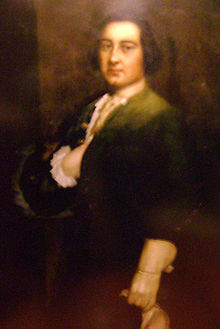Paul Carrington (judge)
Paul Carrington | |
|---|---|
 | |
| Justice of the Virginia Supreme Court | |
| In office December 24, 1788 – July 30, 1807 | |
| Personal details | |
| Born | March 16, 1733 Charlotte County, Colony of Virginia |
| Died | June 23, 1818 (aged 85) Halifax County, Virginia |
| Spouse(s) | Margaret Read, Priscilla Sims |
| Occupation | Lawyer, judge, politician |
Paul Carrington (March 16, 1733 – June 23, 1818) was a
Early life and education
Carrington was born on March 16, 1733, at "Boston Hill" in what was then
After a private education, at about age 17 Carrington began to study (read) law under the direction of Colonel Clement Read in Lunenburg County.
On October 1 of that year he married Margaret Read, Col. Read's second daughter, and they resided at Mulberry Hill. Their children included George Carrington (1756–1809), Mary Scott Carrington Venable (1758–1837), Ann Carrington Cabell (1760–1838), Clement Carrington (1762–1847) and Paul Carrington (1764–1816).[2] His wife died May 1, 1766; Carrington referred to her as "the best of wives and a woman of innumerable virtues."
Career
In May 1755, Carrinton received a license to practice law in Virginia, signed by Peyton Randolph, John Randolph and George Wythe. In 1756, he accepted an appointment as king's attorney (prosecutor) for Bedford County. As he gained legal and political experience, and colonial settlement moved westward, he accepted additional appointments as king's attorney—for Mecklenburg County in 1767, of Botetourt County in 1770, and of Lunenburg County in 1770.
Carrington also became an officer of the Lunenburg County militia, with the rank of major in 1761. In 1764, he became colonel of the Charlotte County militia in 1764. He also served for years a vestryman and churchwarden of Cornwall Parish.
After practicing law in various southern Virginia counties, Carrington was elected as a representative to the

Legislators elected Carrington as a Judge of the first Virginia General Court under the newly adopted Virginia state constitution on January 23, 1778. He was the second Justice appointed to the new Court of Appeals, which was then composed of judges from the General, the Admiralty and the Chancery Courts. In 1780 he became the chief justice of the Virginia General Court. In 1789, he was elected by the Virginia General Assembly to be a justice of the reorganized Virginia Supreme Court of Appeals.[3]
In 1788, Carrington was a delegate to the Virginia Ratifying Convention, which narrowly ratified the
On March 6, 1792, Carrington married his second wife, Priscilla Sims, aged 16. Their children were: Henry Carrington (1793–1867), Lettice Priscilla Carrington Coles (1798–1875), and Robert Carrington (1802–1845). She died in September 1803 and he recorded that her loss was irreparable to him and to their family.[6]
Retirement and death
At age 75, concerned as to his ability to continue judicial duties, Carrington resigned from the bench in 1807. On August 1 of that year he wrote, "I have served the public a great many years, and I know with faithful integrity, I had arrived to a time of life that every man ought, in my opinion, to retire, and not remain and die at his post as some of my brethren have." Judge Carrington lived in retirement another 11 years until he died at the age of 85.[6]
Judge Carrington is buried between his wives on the grounds at
References
- ^ a b Deal, John G. (2006). "Paul Carrington (1733-1818)". Dictionary of Virginia Biography. Vol. 3. pp. 41–43.
- ^ a b Brown, Alexander. The Cabells and Their Kin. Garrett and Massie, 1939, p. 223.
- ^ a b Brown, Alexander. The Cabells and Their Kin. Garrett and Massie, 1939, p. 224.
- ^ Brinkley, John Luster. On This Hill: A narrative history of Hampden–Sydney College, 1774–1994. Hampden–Sydney: 1994, p.10.
- ^ Brown, Alexander. The Cabells and Their Kin. Garrett and Massie, 1939, p. 225.
- ^ a b Brown, Alexander. The Cabells and Their Kin. Garrett and Massie, 1939, p. 226.
- ^ "A Guide to the Carrington Family Papers, 1756-1843 Carrington Family Papers, 1756-1843 20459". ead.lib.virginia.edu. Retrieved 2019-06-13.
